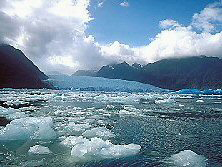Home » Destination
TORRES DEL PAINE AND PUERTO NATALES
 Only 247 kms. northeast of Punta Arenas, Puerto Natales welcomes visitors with its typical black-neck swans and seals, in the middle of a beautiful peer, which invites people to discover one of the most enigmatic places in Chile.
Only 247 kms. northeast of Punta Arenas, Puerto Natales welcomes visitors with its typical black-neck swans and seals, in the middle of a beautiful peer, which invites people to discover one of the most enigmatic places in Chile.
Puerto Natales, which name comes from the word 'natalis' (birth), is the capital of the Ultima Esperanza province, in front of the Andes and by the Senoret Canal, the entrance way to beautiful landscapes such as the Milodon Cave Natural Monument and the Glaciers Natural Park, the ski center in Rio Turbio, the seven glaciers of the Mountain Channel, Sofia, Diana and Dorotea Lagoons; Balmaceda and Toro Lakes; Dorotea and Prat hills; Almirant golf, Cisnes and Guanaco islands; Bories and Consuelo Piers, the Fiscal dock, Paso del Kirke, Antonio Varas Peninsula, Serrano and Tres Pasos Rivers, De Agostini Museum and the Bernardo O 'Higgins National Park, where you can go to the Balmaceda and Serrano Snowdrifts, the Balmaceda Mount, the Pio XI Glacier and the Southern Ice Fields.
There is, however, another place here that is described as one of the most wonderful creations in the planet: the Torres del Paine. Located in the Magallanes region, and 145 kms from Puerto Natales, between the Macizo del Paine and the Patagonia ESTEPA, it is the most recognizable face in the National Park of the same name.
Created in 1959 and named Reserve of the Biosphere by UNESCO in 1978, the Torres del Paine National Park has an area of 242.242 hectares, with mountains as high as 3.050 meters over sea level. There are three entrances to the Park: Sarmiento, Laguna Amarga and Laguna Azul.
In the park you can find the famous Torres (Towers) and Cuernos del Paine (Paine Horns), both of which are mountains of incredible altitude, adorned with snow all year round. Between their peaks there are lakes in the middle of glaciers, which are the home of pumas, guanacos, foxes, condors, wild geese, black-beck swans and native forests, known by the 'beards' they create in this magical place.
There are hotels inside the park, which offer comfort and the proper service to enjoy quietness and relaxation. Also, there are excursions and walks available every day, all of which allow you to visit interesting points inside the park.
Another option is to go trekking, horseback riding, or hiking; there are camping areas and refuges to spend the night surrounded by natural life.
Neccesary information
- When to go
-
Is posible to make the visits into this natural treasure from September up to April.
- Location
- The San Rafael Lagoon is 120 marine miles at the southwest of Puerto Chacabuco, and 180 kilometres southwest of Puerto Aysén.
- Attractions
- The indescriptible landscape that surrounds the San Rafael Lagoon and the imponent eternal ices conform the greatest attractive of this adventure. To this also adds the possibility of fishing and of course, the tradition of whisky with millenial ices taken directly from the lagoon..
- How to get there
- There are two ways to arrive to the National Park San Rafael Lagoon, one is by sea from Puerto Chacabuco, with a beautiful trip up to the lagoon travelling 8 hours approximately, but it depends on the craft because the time on catamaran is 4 hours. The other way to arrive is by air up to the airport of Balmaceda, travelling 3 hours from Santiago. Then, you arrive to the aerodrome on the National Park Laguna San Rafael with one hour and a half flying.
- Destination
-
- Torres of Paine Base
- Cerro Castillo
- Puerto Eden
- Costanera Puerto Natales
- Balmaceda Glacier
- Grey Glacier
- Pio XI Glacier
- Serrano Glacier
- Tyndall Glacier
- Pingo Glacier
- Lake Balmaceda
- Lake Grey
- Lake Nordenskjold
- Lake Paine
- Lake Pehoe
- Lake Toro
- Lake Dickson
- Lake Sarmiento
- Milodon Cave Natural Monument
- National Park Bernardo Ohiggins
- Torres del Paine National Park
- Puerto Eden
- Puerto Natales
- Salto Grande
- Salto Chico
- National Reserve Alacalufe

